We all know that exercise is an essential aspect of maintaining fitness and overall health. But there are many forms and markers used to determine the effectiveness of a workout.
One of the measures that have become increasingly popular is the use of heart rate zones, which can monitor both the rigour and intensity of your workouts. So how does one measure their heart rate zones and how can they be utilised during workouts?

Highlights
- Heart rate colour zones are a way to monitor the intensity of training by measuring your heart rate,
- The purpose of the heart rate zones is to enable you to discover the types of workouts that serve different functions,
- These colour zones help you understand which workout stage you’re in, and how to optimise your workout.
What are Heart Rate Zone Colours?
Your heart rate, which measures how many times your heart beats per minute, can vary according to your age, gender and level of activity. Everyone has a resting heart rate and a ‘maximum heart rate’, which is the beats per minute at the highest level of vigorous exercise. Different physical activities or types of exertion can cause your heart rate to change or heart rate variability[HRV].
Simply put, heart rate zones or heart rate colour zones are a way to monitor the intensity of training by measuring your heart rate. Using your heart rate, it’s possible to define the workout or type of training most appropriate for you. Heart rate zones can be best understood as a percentage of your maximum heart rate, depending on your level of exertion.
So, what are the zones?
Five Types of Heart Rate Zone Colours
Which are categorised by colour. They are”:
- Blue zone
This represents 50 to 60 per cent of your maximum heart rate—usually the warm-up or cool-down stage of a workout. - Green Zone
This is around 60 to 70 per cent of your maximum heart rate, and represents a moderate level of activity. - Yellow Zone
This zone represents around 70 to 80 per cent of your maximum heart rate[MHR], and helps to build endurance and muscle. - Orange Zone
This is about 80 to 90 per cent of your maximum heart rate[MHR], and is the anaerobic threshold, which means the point at which your body does not provide enough oxygen for the needs of the muscles. - Red Zone
This is the most intense zone, which lies between 90 to 100 per cent of your maximum heart rate[MHR], and should only be reached in very short bursts.
Some athletes or workouts categorise these into only three zones (Blue, Yellow and Red), with larger intervals that include the others. The purpose of the heart rate zones is to enable you to discover the types of workouts that serve different functions, such as resistance, endurance, muscle building, and so on. So how can the zones be calculated?

How to Calculate Heart Rate Zones?
The average resting heart rate for most adults is between 60 to 100 beats per minute. Each person has a maximum heart rate (also known as a maximum cardio percentage or sometimes calculated using VO2 Max), which depends on factors like age and gender.
There are a number of ways to calculate your maximum heart rate or the maximum number of times your heart should beat during activity.
One is to subtract your age from 220, which gives a rough estimate and was commonly used for many years. So if you are 25 years old, your maximum heart rate would be 220 – 25 which equals 195.
However, this method is not as accurate as the formula that a number of studies have referred to.
This formula takes into account gender and is different for males and females.
Calculate Heart rate zone for Males
maxHR = 208.609 – (0.716 x age).
Calculate Heart rate zone for Females
max HR = 209.273 – (0.804 x age).
So for a 30-year-old male, this formula would suggest an HR Max of about 187. There are also a number of online calculators that can help you determine your maximum heart rate accurately.
Of course, the most reliable way to measure the HR Max is to take a VO2 Max test in a gym or clinic, but this formula does offer an accurate estimate.

Why you should use Heart Rate Zones?
As mentioned earlier, heart rate zones are not just used to calculate your maximum capacity, but also to know which workout stage you’re in, and how to optimise your workout to maximise its benefits.
By monitoring your heart rate during a workout, you can know your colour zone and shift between zones, since greater variation helps you reach your goals faster, and have applications both for athletic training and overall fitness.
Broadly, the zones in ascending order of difficulty correspond to different stages or intervals of a workout.
The blue zone is usually for warm-up and recovery, the green for basic endurance, the yellow for active endurance, orange for resistance, and red for heavy resistance or maximum intensity.
Moving between zones creates an oxygen deficit in the body, leading to energy being derived from calories or fat in the body, and it will also allow you to continue burning calories post-workout.
There are various other reasons why knowing your heart rate zones and monitoring them can be beneficial, particularly for athletic training.
Why is it Important to Understand Heart Rate Zones?
- Getting an accurate picture of intensity levels
Studies have shown that beginners tend to overestimate their intensity level while advanced athletes are inclined to underestimate it. In both cases, using heart rate zones can provide data that allows them to remain within the intended range and see the benefits of that particular workout. - Avoiding overtraining
Having heart rate data allows athletes to prevent overworking during sessions that should be easy or moderate, and give their bodies enough time for recovery. - Applicable to all workouts
Another benefit of using heart rate zones is that they serve as the best indicator of how hard your body is working regardless of the type of activity. From running to cycling to weights or HIIT, using heart rate data can allow you to better plan your targets and improve workouts.
Any workout routine can benefit from including a variation of all of the zones since this variation allows you to avoid hitting a plateau or injuring yourself through incorrect training or overtraining.
Moreover, a number of studies have shown that using heart rate tracking devices such as wearable tech or monitoring heart rate zones can improve athletic performance, overall health and training regimes for individuals.

Which Heart Rate Colour Zone should you Workout in?
So which zone should you work out in? As discussed earlier, this depends upon the target of the workout, and any holistic workout plan should include time spent across each zone.
The frequency, duration and intensity of your activity in each zone should vary over the course of a week since the variation between heart rate zones is what helps you reach your fitness goals.
Each zone serves a particular function—simplistically, blue and green allow you to build stamina and a foundation, yellow and orange improve endurance and allow you to build muscle, while red can push your capacity further and burn fat most effectively.
Since the orange and red zones are where anaerobic activity occurs, they can have more impact but must be balanced out with longer periods of endurance training.
Below is a breakdown of the ‘purpose’ that each Heart Rate colour zone serves:
- Blue Zone: Most important for warming up and recovering, allowing the muscles to eliminate waste after an intense workout.
- Green Zone: Improves endurance and allows for muscle toning, building a foundation for more intense activity. Should be done for longer durations.
- Yellow Zone: Works up a sweat and builds endurance for moderate to long periods of exercise. This is the point where you are within the aerobic threshold, but still pushing your body.
- Orange Zone: This is the point where the body crosses into anaerobic activity, and starts burning fuel from glucose or fat. This zone is best to push for about 10-15 minutes at a time.
- Red Zone: The maximum intensity zone, which shouldn’t be sustained for more than 30 seconds to 2 minutes. This is where the most fat is burned, but cannot be attained safely before sufficient time is spent in the other zones.
Although different trainers or experts suggest different workout regimes based on your goals and fitness level, a holistic workout plan generally includes two to three days a week of workouts that are pushed to the orange and red zones, two to three days in the green and yellow zones and the rest in the blue zone to ensure sufficient recovery.
Conclusion
Heart rate colour zones are a way of using your maximum heart rate as a measure to determine the best practices when it comes to exercising. Using heart rate colour zones to monitor your exercise levels and improve overall fitness has various benefits. They can be an effective tool that will help with burning calories and building muscle, and being aware of them can also help individuals train better, particularly athletes.
Disclaimer: The contents of this article are for general information and educational purposes only. It neither provides any medical advice nor intends to substitute professional medical opinion on the treatment, diagnosis, prevention or alleviation of any disease, disorder or disability. Always consult with your doctor or qualified healthcare professional about your health condition and/or concerns and before undertaking a new health care regimen including making any dietary or lifestyle changes.
References








